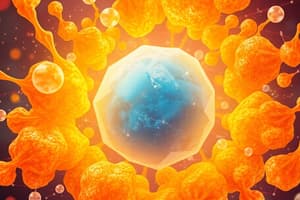Podcast
Questions and Answers
What type of bond connects two monosaccharides in a disaccharide?
What type of bond connects two monosaccharides in a disaccharide?
- N-glycosidic bond
- Hydrogen bond
- O-glycosidic bond (correct)
- Peptide bond
What is a function of homopolysaccharides?
What is a function of homopolysaccharides?
- Form the cell membrane
- Contribute to genetic information
- Serve as storage forms of monosaccharides (correct)
- Provide extracellular support
What is the composition of peptidoglycan in bacterial cell envelopes?
What is the composition of peptidoglycan in bacterial cell envelopes?
- Cellulose and chitin
- Two alternating monosaccharide units (correct)
- A single type of sugar
- Only amino acids
How does boiling with dilute acid affect disaccharides?
How does boiling with dilute acid affect disaccharides?
What are the two components of starch?
What are the two components of starch?
What type of linkages are found in the chains of amylose?
What type of linkages are found in the chains of amylose?
What distinguishes amylopectin from amylose?
What distinguishes amylopectin from amylose?
What is the primary role of heteropolysaccharides in animal tissues?
What is the primary role of heteropolysaccharides in animal tissues?
Which of the following is NOT a characteristic of glycosidic bonds?
Which of the following is NOT a characteristic of glycosidic bonds?
What structural feature distinguishes glycoproteins from proteoglycans?
What structural feature distinguishes glycoproteins from proteoglycans?
What is the primary role of lectins in organisms?
What is the primary role of lectins in organisms?
Which statement about glycolipids is correct?
Which statement about glycolipids is correct?
What is the significance of proteoglycan aggregates?
What is the significance of proteoglycan aggregates?
What functional role do glycoproteins serve in the cell membrane?
What functional role do glycoproteins serve in the cell membrane?
Which of the following accurately describes the oligosaccharide linkages in glycoproteins?
Which of the following accurately describes the oligosaccharide linkages in glycoproteins?
What type of interactions stabilize the three-dimensional structure of polysaccharides?
What type of interactions stabilize the three-dimensional structure of polysaccharides?
What is the three-dimensional structure of starch and glycogen primarily characterized by?
What is the three-dimensional structure of starch and glycogen primarily characterized by?
What color does iodine solution give when it interacts with starch?
What color does iodine solution give when it interacts with starch?
What are the two major components of agar?
What are the two major components of agar?
What property of agarose makes it useful in biochemistry laboratories?
What property of agarose makes it useful in biochemistry laboratories?
What is the extracellular matrix primarily composed of?
What is the extracellular matrix primarily composed of?
Which monosaccharide is always present in glycosaminoglycans?
Which monosaccharide is always present in glycosaminoglycans?
What role do glycosaminoglycans play in the body?
What role do glycosaminoglycans play in the body?
What is a common feature of glycosaminoglycans regarding their structure?
What is a common feature of glycosaminoglycans regarding their structure?
What can happen to the hydroxyls of amino sugars in some glycosaminoglycans?
What can happen to the hydroxyls of amino sugars in some glycosaminoglycans?
What role does heparin play in blood samples and transfusions?
What role does heparin play in blood samples and transfusions?
What type of bond is hydrolyzed by lysozyme to kill bacteria?
What type of bond is hydrolyzed by lysozyme to kill bacteria?
Which macromolecule primarily serves as a rigid component of bacterial cell walls?
Which macromolecule primarily serves as a rigid component of bacterial cell walls?
What is the primary function of proteoglycans in the extracellular matrix?
What is the primary function of proteoglycans in the extracellular matrix?
What substance is known to prevent the synthesis of cross-links in bacterial cell walls?
What substance is known to prevent the synthesis of cross-links in bacterial cell walls?
What is known to have the highest negative charge density among biological macromolecules?
What is known to have the highest negative charge density among biological macromolecules?
Which of the following best describes the structure of peptidoglycan?
Which of the following best describes the structure of peptidoglycan?
What is the main consequence of osmotic lysis in bacteria?
What is the main consequence of osmotic lysis in bacteria?
Which carbohydrate-containing molecules are important for cell-cell recognition?
Which carbohydrate-containing molecules are important for cell-cell recognition?
What purpose do glycosaminoglycan chains serve in proteoglycans?
What purpose do glycosaminoglycan chains serve in proteoglycans?
What is the repeating disaccharide unit found in hyaluronate?
What is the repeating disaccharide unit found in hyaluronate?
How many disaccharides does hyaluronate contain per chain?
How many disaccharides does hyaluronate contain per chain?
What is a key function of chondroitin sulfate?
What is a key function of chondroitin sulfate?
Which glycosaminoglycan is known for having variable sulfate content?
Which glycosaminoglycan is known for having variable sulfate content?
What type of enzyme is hyaluronidase and what does it do?
What type of enzyme is hyaluronidase and what does it do?
Heparin is produced in which type of cell?
Heparin is produced in which type of cell?
What function does heparin serve in the body?
What function does heparin serve in the body?
Which glycosaminoglycan primarily contributes to the pliability of skin?
Which glycosaminoglycan primarily contributes to the pliability of skin?
How do other glycosaminoglycans generally differ from hyaluronate?
How do other glycosaminoglycans generally differ from hyaluronate?
What is the molecular weight of hyaluronate typically greater than?
What is the molecular weight of hyaluronate typically greater than?
Flashcards are hidden until you start studying
Study Notes
Disaccharides
- Disaccharides are composed of two monosaccharides, joined by an O-glycosidic bond.
- This bond forms when a hydroxyl group of one sugar reacts with the anomeric carbon of the other.
- Disaccharides can be hydrolyzed to yield their free monosaccharide components by boiling with dilute acid.
- N-glycosyl bonds join the anomeric carbon of a sugar to a nitrogen atom in glycoproteins and nucleotides.
Polysaccharides
- Homopolysaccharides contain only a single type of monomer, e.g. starch.
- Heteropolysaccharides contain two or more different kinds of monomers, e.g. peptidoglycan.
Functions of Polysaccharides
- Homopolysaccharides like starch and glycogen serve as storage forms of fuel for cells.
- Homopolysaccharides like cellulose and chitin serve as structural elements.
- Heteropolysaccharides provide extracellular structural support for organisms of all kingdoms.
- Heteropolysaccharides in animal tissues form a matrix that holds individual cells together and provides shape and support.
Starch
- Starch contains two types of glucose polymer: amylose and amylopectin.
- Amylose consists of long, unbranched chains of D-glucose residues connected by (α1→4) linkages.
- Amylopectin is highly branched.
- The branch points in amylopectin are (α1→6) linkages.
Folding of Homopolysaccharides
- Polysaccharides form 3-dimensional structures stabilized by weak interactions: hydrogen bonds, hydrophobic interactions, van der Waals interactions, and electrostatic interactions.
- The most stable 3-dimensional structure for starch and glycogen is a tightly coiled helix.
- The helix can accommodate iodine, which can be used as a qualitative test for amylose.
Agarose
- Agarose is a mixture of sulfated heteropolysaccharides made up of D-galactose and an L-galactose derivative.
- The two major components of agar are agarose and agaropectin.
- The gel-forming property of agarose makes it useful in the biochemistry laboratory.
Glycosaminoglycans
- Extracellular matrix (ECM) is a gel-like material that holds cells together and provides a porous pathway for nutrient and oxygen diffusion.
- The ECM is composed of an interlocking meshwork of heteropolysaccharides and fibrous proteins.
- Glycosaminoglycans are linear polymers of repeating disaccharide units.
- One of the two monosaccharides is always either N-acetylglucosamine or N-acetylgalactosamine; the other is usually a uronic acid (D-glucuronic or L-iduronic acid).
- Some glycosaminoglycans have hydroxyl groups esterified with sulfate.
- Attached to extracellular proteins, glycosaminoglycans form proteoglycans.
Hyaluronate
- Hyaluronate has alternating residues of D-glucuronic acid and N-acetylglucosamine.
- Hyaluronate has a molecular weight greater than 1 million and forms clear, highly viscous solutions.
- The viscous properties make it a lubricant in synovial fluid and contribute to the strength and elasticity of cartilage and tendons.
Hyaluronidase
- Hyaluronidase is an enzyme secreted by some bacteria.
- It hydrolyzes the glycosidic linkages of hyaluronate, making tissue more susceptible to bacterial invasion.
- Sperm also uses similar enzymes to hydrolyze an outer coat surrounding the ovum to allow for penetration.
Chondroitin Sulfate
- Chondroitin sulfate is a glycosaminoglycan with repeating disaccharide units of N-acetylgalactosamine and glucuronic acid.
- Chondroitin sulfate contributes to the tensile strength of cartilage, tendons, ligaments, and the walls of the aorta.
Dermatan Sulfate
- Dermatan sulfate is similar to chondroitin sulfate but with glucuronic acid replaced by iduronic acid.
- Dermatan sulfate contributes to the pliability of skin and is also present in blood vessels and heart valves.
Keratan Sulfate
- Keratan sulfates have no uronic acid and variable sulfate content.
- They are present in cornea, cartilage, bone, and in horny structures like hair, nails, hoofs, and claws.
Heparin
- Heparin is a natural anticoagulant made in mast cells.
- It binds to and inhibits the protein antithrombin, which in turn inhibits thrombin, a protease essential to blood clotting.
- Heparin is routinely added to blood samples and donated blood to prevent clotting.
Glycoconjugates
- In addition to functions as stored fuels and structural materials, polysaccharides and oligosaccharides act as information carriers.
- Glycoconjugates are biologically active molecules containing carbohydrates covalently joined to proteins or lipids.
Bacterial Cell Wall: Peptidoglycan
- The rigid component of bacterial cell walls is a heteropolymer of alternating (β1→4)-linked N-acetylglucosamine and N-acetylmuramic acid residues.
- Linear polymers are cross-linked by short peptides to create a strong sheath that envelops the cell—preventing lysis due to osmotic pressure.
- The enzyme lysozyme kills bacteria by hydrolyzing the glycosidic bond between N-acetylglucosamine and N-acetylmuramic acid.
- Penicillin and related antibiotics kill bacteria by preventing synthesis of the cross-links.
Proteoglycans
- Proteoglycans are macromolecules containing glycosaminoglycan chains covalently joined to a membrane protein or a secreted protein.
- They are major components of connective tissue, contributing to strength and resilience.
- Proteoglycans can form proteoglycan aggregates, which are enormous supramolecular assemblies of many core proteins bound to a single molecule of hyaluronic acid.
Glycoproteins
- Glycoproteins are carbohydrate-protein conjugates with smaller, branched, and more diverse glycans than the glycosaminoglycans of proteoglycans.
- They are found on the outer face of the plasma membrane, in the ECM, and in the blood.
- The oligosaccharide portions of glycoproteins are less complex than the glycosaminoglycan chains of proteoglycans.
- Glycoproteins form highly specific sites for recognition and binding by other proteins.
Glycolipids
- Glycolipids are membrane lipids with oligosaccharide head groups.
- They act as specific sites for recognition by carbohydrate-binding proteins.
- Glycolipids are involved in intercellular communication.
- Oligosaccharides in glycolipids and glycoproteins serve as cell recognition factors in cell membranes.
- The carbohydrate residues in these oligosaccharides are the antigens of the ABO blood group substances.
Carbohydrate-Protein Interaction
- Lectins bind carbohydrates with high affinity and specificity.
- Lectins serve in cell-cell recognition, signaling, adhesion processes, and intracellular targeting of proteins.
Studying That Suits You
Use AI to generate personalized quizzes and flashcards to suit your learning preferences.




